#Sari era is over?
Text
Sari out for the euros
I feel bad for Sari tho but if she was healthy after the injury, watch Mark Parsons pull a Jorge Vilda and put her back on the pitch 😵💫
Meet the young goalies:
Daphne Lize


Jacintha

I’m certain big clubs will be watching Daphne

Lize is a fashionista at heart who was injured that’s why she’s not in the current squad.
#Mark pulling a Jorge Vilda for sure if Sari was healthy#Sari era is over?#can’t wait to see how Daphne is gonna be doing#nedwnt#oranje leeuwinnen#weuro2022#euro’s 2022#oranjeleeuwinnen#daphne van domselaar#Lize kop#Jacintha Weimar#sari van veenendaal#ned wnt
9 notes
·
View notes
Note
While we’re on the subject of names, is there an explanation for how traditional nicknames came about that are seemingly unrelated to, or have little in common with, the original name?
ie- John/Jack, Richard/Dick, Henry/Harry/Hank, Charles/Chuck, Margaret/Peggy/Daisy, Sarah/Sally, Mary/Molly, Anne/Nan, etc
I am actually over a week into researching a huge follow-up post (probably more than one if I’m being honest) about the history of nickname usage, so I will be going into this in much, much more detail at a hopefully not-so-later date - if I have not lost my mind. (Two days ago I spent three hours chasing down a source lead that turned out to be a typographical error from 1727 that was then quoted in source after source for the next 150 years.)
As a preview though, here’s some info about the names you mentioned:
The origins of a good portion of common English nicknames come down to the simple fact that people really, really like rhyming things. Will 🠞Bill, Rob🠞Bob, Rick🠞Dick, Meg🠞Peg.
It may seem like a weird reason, but how many of you have known an Anna/Hannah-Banana? I exclusively refer to my Mom’s cat as Toes even though her name is Moe (Moesie-Toesies 🠞 Toesies 🠞 Toes).
Jack likely evolved from the use of the Middle English diminutive suffix “-chen” - pronounced (and often spelled) “-kyn” or “kin”. The use of -chen as a diminutive suffix still endures in modern German - as in “liebchen” = sweetheart (lieb “love” + -chen).
John (Jan) 🠞 Jankin 🠞 Jackin 🠞 Jack.
Hank was also originally a nickname for John from the same source. I and J were not distinct letters in English until the 17th Century. “Iankin” would have been nearly indistinguishable in pronunciation from “Hankin” due to H-dropping. It’s believed to have switched over to being a nickname for Henry in early Colonial America due to the English being exposed to the Dutch nickname for Henrik - “Henk”.
Harry is thought to be a remnant of how Henry was pronounced up until the early modern era. The name was introduced to England during the Norman conquest as the French Henri (On-REE). The already muted nasal n was dropped in the English pronunciation. With a lack of standardized spelling, the two names were used interchangeably in records throughout the middle ages. So all the early English King Henrys would have written their name Henry and pronounced it Harry.
Sally and Molly likely developed simply because little kids can’t say R’s or L’s. Mary 🠞 Mawy 🠞 Molly. Sary 🠞 Sawy 🠞 Sally.
Daisy became a nickname for Margaret because in French garden daisies are called marguerites.
Nan for Anne is an example of a very cool linguistic process called rebracketing, where two words that are often said/written together transfer letters/morphemes over time. The English use of “an” instead of “a” before words beginning with vowels is a common cause of rebracketing. For example: the Middle English “an eute” became “a newt”, and “a napron” became “an apron”. In the case of nicknames the use of the archaic possessive “mine” is often the culprit. “Mine Anne” over time became “My Nan” as “mine” fell out of use. Ned and Nell have the same origin.
Oddly enough the word “nickname” is itself a result of rebracketing, from the Middle English “an eke (meaning additional) name”.
I realized earlier this week that my cat (Toe’s sister) also has a rebracketing nickname. Her name is Mina, but I call her Nom Nom - formed by me being very annoying and saying her name a bunch of time in a row - miNAMiNAMiNAM.
Chuck is a very modern (20th century) nickname which I’ll have to get back to you on as I started my research in the 16th century and am only up to the 1810s so far lol.
#names#nicknames#onomastics#history#asks#nicknames are really hard to research you guys#there is so much info out there and it's almost all nonsense#and I'm talking academic books with listed sources not buzzfeed listicles#some guy in the 18th century forgetting to mention Bill on a list of common nicknames does not mean it wasn't in use at the time ma dude#i've had to get very creative with sources#god bless word for word murder trial testimony
2K notes
·
View notes
Note
Can I get platonic maximals with a reader who’s a technorganic (half human, half cybertroian. Like Sari from transformers animated) where Optimus Primal, Rhinox, Dinobot, and Rattrap become father figures to the reader please.
Haven't done one on a Techno Organic in a while. This was good practice. Sari was a good character in TFA. Lets see our fellow Maximal doing with Buddy.
Hope you enjoy!
Optimus Primal, Rhinox, Dinobot, Rattrap being Father figures to a Sari like Techno Organic
SFW, Familial, platonic, Techno Organic reader
Beast Wars
Optimus Primal
“I guess I have another kid now.”
He is one of the more open members of the Maximals to include Buddy in their little family.
He is a bit weirded out at the Techno Organic nature of Buddy but is quick to get over it. They took animal alt modes after all; they aren’t too different from one another.
The thing he is weirded by is that Buddy is an advance human. He has nothing against humans. He is used to seeing primitive humans around, not one with many advancements. If he hears someone talking badly about Buddy’s origins, someone is going to have to answer to an angry ape.
He does take time from his day to spend it with Buddy, whether that be chatting on patrol or flying around on their jetpacks. Welcome to parenthood Primal.
Has been the victim of surprise ‘piggyback rides’ in his beast mode. He doesn’t mind it too much.
If Buddy feels insecure about being part Cybertronian, part Human he is there to help them out of that pit of self-doubt and self-loathe.
There is no holding back this ape if Buddy gets hurt by the Predacons. This is a wild ape with swords, things will get destroyed.
“Hey Dad, can we go out now?”--Buddy
*Voice crack* “Sure thing Buddy.”—Optimus
Rhinox
“Oh, Hello there. Nice to meet you!”
He finds Buddy to be interesting when they first meet.
Like Primal he is one of the first to open to Buddy. He finds their complexity fascinating; he has never seen something like this before. He has no problem with them being who they are, will put someone in their place if they say otherwise.
He is also a prime target for the ‘piggyback rides’ but he doesn’t mind whether in bi-pede mode or beast mode.
His time with Buddy usually happens when they are stuck in the base with him or when they are trailing behind him looking at the different species of flowers around. He greets parenthood with open arms.
“Hey Papa! Look at this drawing I did of the flowers we saw yesterday!”--Buddy
“That’s beautiful Buddy. I’m proud of you kid.”—Rhinox
Dinobot
“What in the inferno is that?”
Yeah, he is a bit freaked out first seeing Buddy.
He doesn’t want anything to do with Buddy at first. Sees them as some sort of nuisance at first, until they unlock their weapons system. Now he sees the equivalent of an armed toddler running around the base. They need someone with actual weapons to guide them.
While he was quick to judge Buddy in the beginning, he is just as quick to give a verbal or physical lashing to anyone who talks badly about Buddy.
He forms a mentorship with Buddy before knowing what parenthood was. After he does realize that he is going to protect Buddy with all he has.
Doesn’t do the ‘piggyback rides’…but in private though…
When he learns of Buddy’s unkind feelings towards themselves, he has one of the greatest warrior speeches that go on par with Optimus’s speeches. He is making sure that those thoughts don’t show their ugly heads again.
Oh, Megatron best hope that Dinobot never finds out that Buddy was ever hurt by anyone in his army. There would not be a single thought running through his head that doesn’t a line with hurting the attacker badly.
“Pa, have you seen my swords? I swear I left—”--Buddy
Clank!
“…Guys I think I broke him?”—Buddy
Rattrap
“Just when I though humans couldn’t get any weirder…”
He does find Buddy creepy at first. He has had time to meet and greet the humans of this era and they aren’t exactly the smartest of the bunch. Rattrap doesn’t trust them for the longest time too.
When he finds out Buddy being called certain names, he is ready and armed to the teeth to defend them. Little guys have to stick together in this world after all.
After a bit though, he tends to stick by Buddy more often than he would want to admit it. Welcome to parenthood.
He sasses Buddy the entire time they are on his back doing the ‘piggyback rides’… but he doesn’t kick them off.
If he gets a whiff that Buddy has unkind thoughts about themselves, he will talk some sense into them explaining how much cooler they are to certain team members and that they should be proud of the little being they are.
He is willing to go back into the Predacon base to ruin every single wiring if he ever found out that Buddy was hurt by one of them.
“Hey Pops, can you pass me that wrench?”--Buddy
“Sure, Kiddo give me a second. I think I left it in Chomperfaces room.”—Rattrap
#transformers x reader#transformers#transformers beast wars#bw optimus primal#bw rattrap#bw dinobot#rhinox#maccadam#techno oranic buddy
63 notes
·
View notes
Text
uncle brought over my stack of art school era (2013~) artwork plates thats been gathering dust in my old dorm and i kinda wanna share a few. bear with me almost all of these are abstract shit bc you know...fine arts academia. idk
one of the first plates and single-handedly is to blame for my disdain of drawing straight lines: color mixing chart we have to mix poster color paint for each square and i was poor so i only had the primaries

i had a pretty high grade here iirc but anyway this is so fucking pointless what the fuck am i gonna do with this and now i just hate rulers and ruling pens
---
color theory/scheme plate and im here to announce that yes, turning brain off and adding as much detail as possible has been a decade old technique apparently

principles of design plate?

ngl i still like this one bc look at it
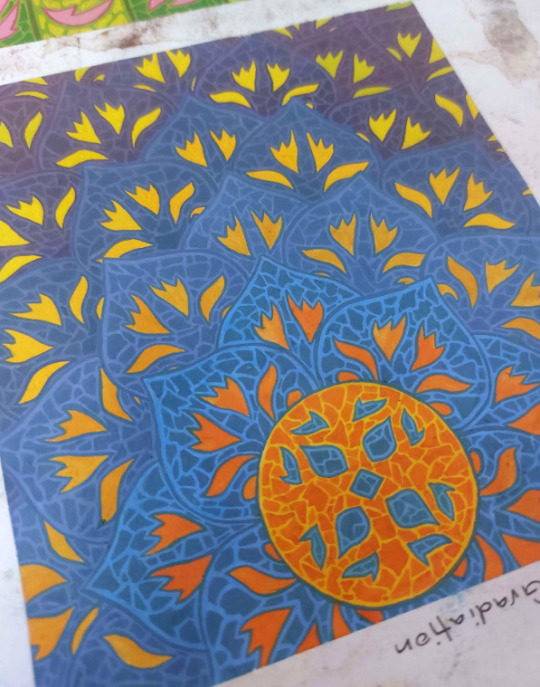
the concept of horror vacui has stayed in my brain and tbf my prof liked it bc it looks like i put effort. i did, technically, but like how i draw now, its just therapeutic to not think and just move hands instead
----
printmaking plates! lino-cut prints, to be exact. many stabbings happened in the making of these. i think the way i do inktobers have been mostly derived from these. and lino-cuts print is something ive been wanting to pursue but its such an expensive and space consuming medium and that makes me sad. anyway,
prompt here is reframing fairy tales into Philippine culture/setting. so hansel and gretel in a sari-sari store
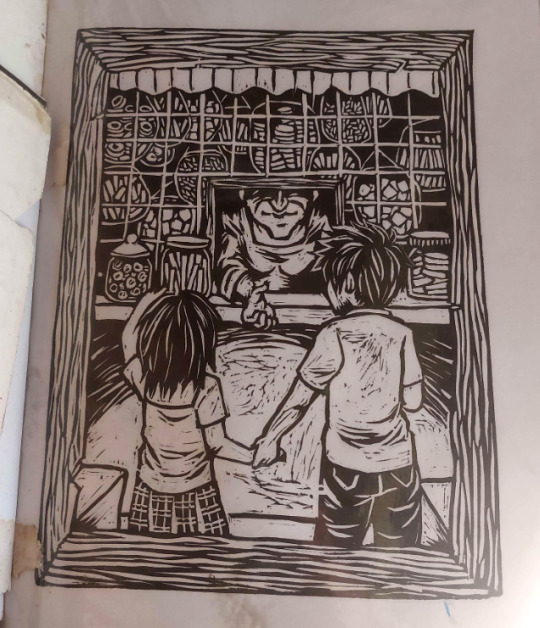
i used OCs for the characters here, and the owner of the' taller boy 'hansel' hasn't been my friend for years now but damnit i still love this concept and she's not ruining this for me
prompt for this one is 'morning'. so here's me in my depression college dorm, booting up for the day. rip to my childhood Buttercup doll, i don't know where you are now

----
last im willing to show is this pest-eaten watercolor landscape painting of UP Lagoon.

look, we had to go out into a mosquito-infested area at 3pm (the start of our watercolor techniques class) and paint this before 5:30 (end of class) but in practice its less than an hour time bc the sun was setting and we can't see shit anymore let alone what color that one flower is.
turned out p good still i think
#im surprised how well preserved the colors of the poster paint are for smth i just bought in whatever school supply store#also im p sure i have better pics of these in my portfolio blog freshly photographed from years ago
39 notes
·
View notes
Photo
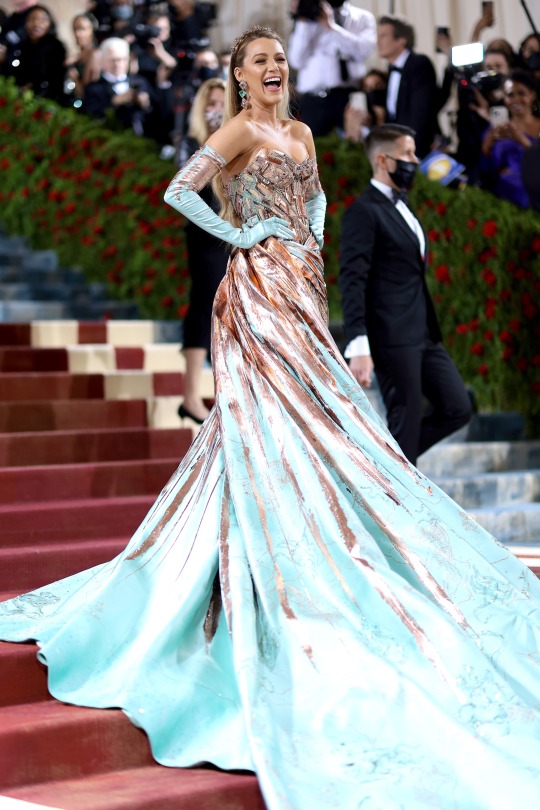
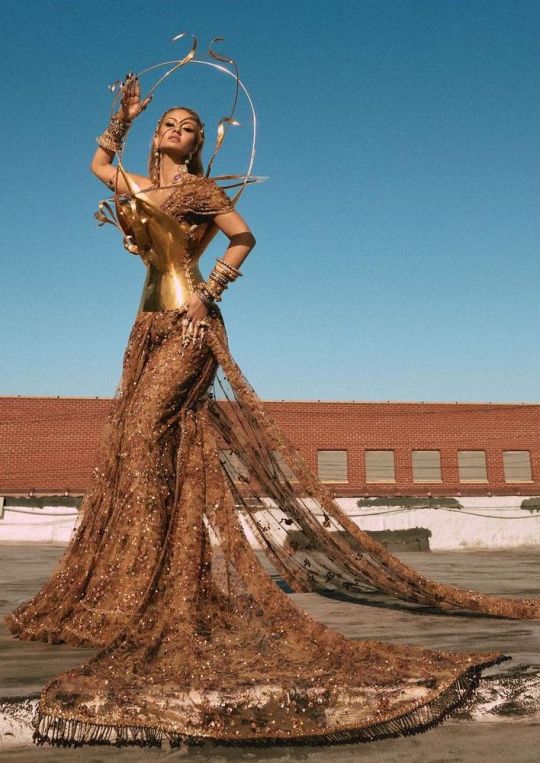



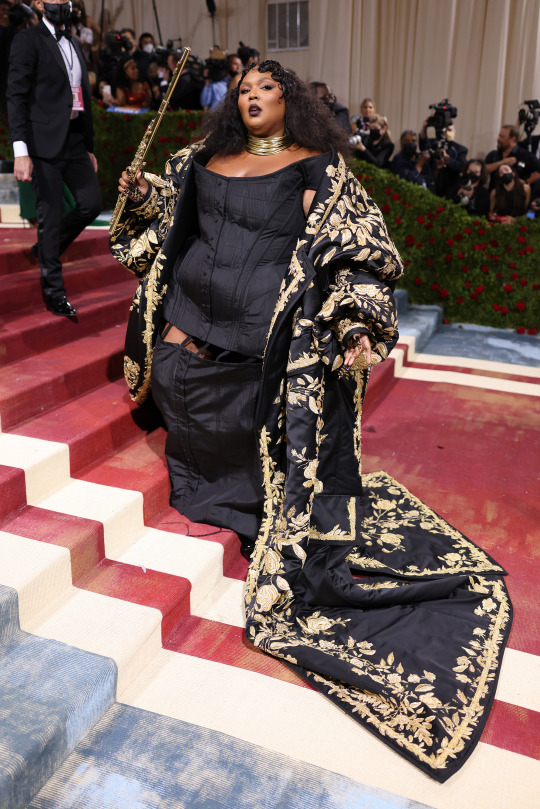
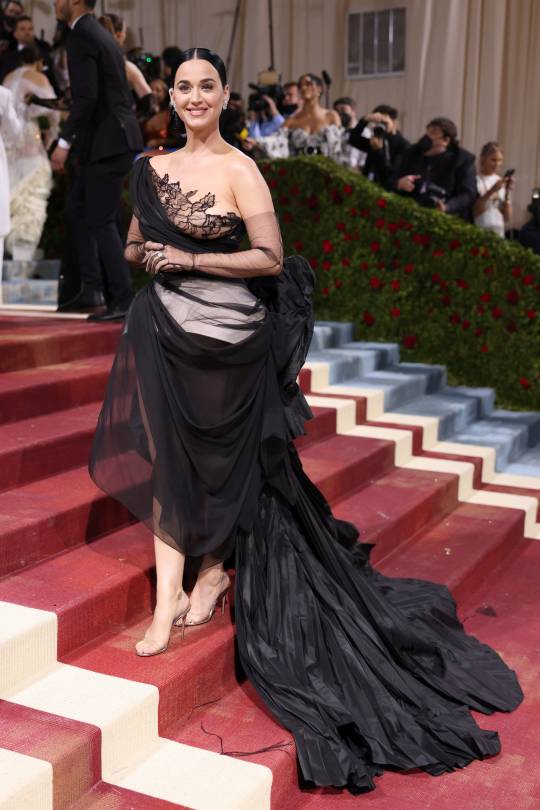


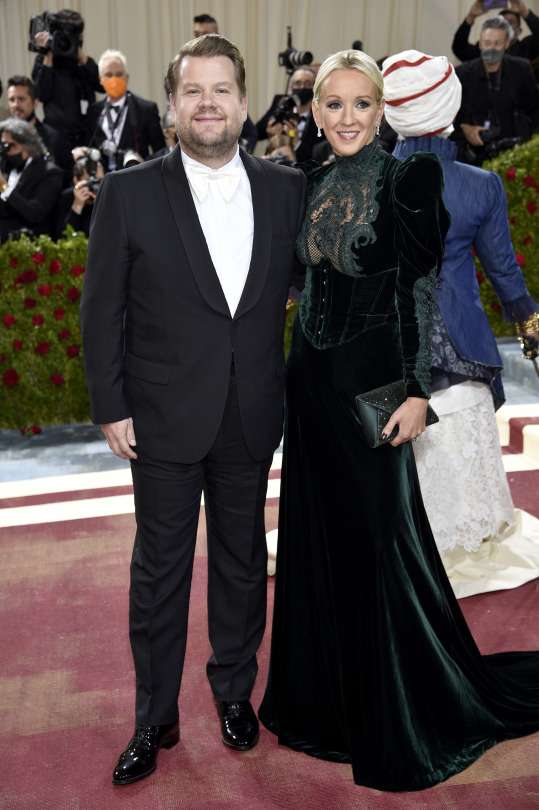
Top Met Gala 2022 Picks Part 1: On Theme
Updated with opinions
This isn’t to say other looks weren’t on theme, but these were ones that I liked because they were on theme.
From top to bottom, in no particular ranking:
Blake Lively
She put so much thought into all of the references in this look. It actually wasn’t my favorite look based on appearances, but I give it top marks for the effort and the research. The transformation was cool, but the video is actually underwhelming it plays out better in stills.
Natasha Poonawalla
I saw a flash of this on TV and then spent all night trying to figure out who it was. Definitely fits “gilded glamor” theme, and I love the combination of a Schiaparelli corset over a couture sari.
Nicola Coughlan
This is the kind of gilded age drama I was hoping for last night! Sleeves, feathers, corset, trains! I kind of wish she had worn her hair up but down is a more modern interpretation
Anitta
I love the off the shoulder with the pearls draped through it, it reminds me of the over-the-top accessorizing in old portraits. The peplum is a bit more cinderella than gilded age, but I’ll take it
Stephen Jones and Amy Fine Collins
The only people here who looked like they could have been in a period piece. They knew what they were doing and had fun with it
Lizzo
I’m more focused on the gorgeously embroidered house coat/cape which screams gilded age opulence to me, though I do appreciate the corset underneath. Also, she brought her FLUTE. It was criminally underrated on the broadcast last night.
Katy Perry
Initially I didn’t love it, but then I saw it from another angle and totally got the gilded age inspiration. The silhouette, bustle, draping, and train all fit the theme, in a more modern way. Even the white mini skirt underneath is reminiscent of a petticoat. I just wish she had done better styling
Taylor Hill
Super surprised here, since Taylor usually goes for the “off theme pretty model” look. The off the shoulder neckline with big flowers reminds me of some 1800′s dresses, as do the boots with all the tiny buttons. It’s not shown here, but the embroidered train is truly show stopping
Laura Harrier
It’s glamorous. It has a fancy, shiny print I could totally see in the era. Is the silhouette a little pre-gilded age to me? Yeah but I love it.
Julia Carey
Focusing on her, and her alone, this was probably the most on theme look to me all night. It’s got everything: lace, velvet, a corset, puffy shoulders with longs sleeves. It’s perfect.
390 notes
·
View notes
Text
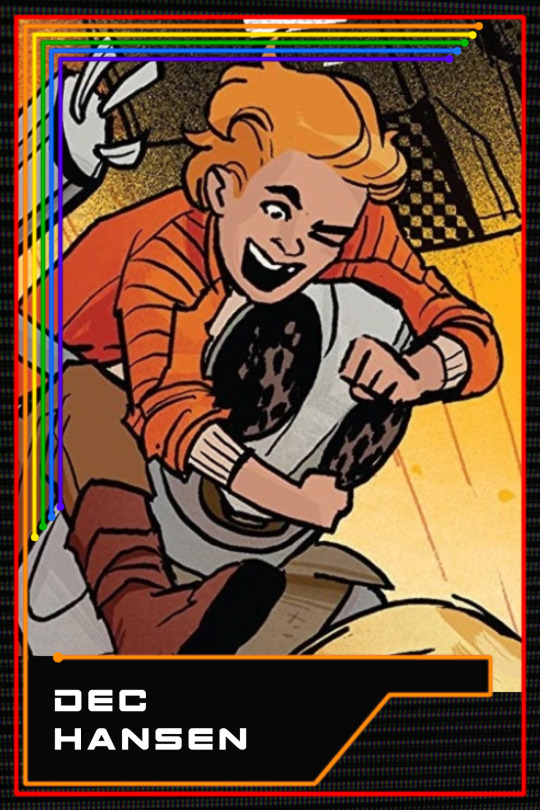
Name: Dec Hansen
Pronouns: he/him
Era: First Order
Appears in: Join the Resistance trilogy
Dec Hansen was a scavenger and tinkerer who, with his droid "brother" AG-90, joined the Resistance as part of J-Squadron. He was a charming troublemaker and fiercely loyal to his friends. While not made explicit in canon, co-author Ben Blacker stated that he wrote Dec as a gay character, alluding to this through Dec's story about being "different from everyone else" and quotes other characters ("I've never known him to like a girl. It's just not how he is.")
Fun fact: Dec is the first gay character in a Star Wars children's book!
Check out Dec's video profile here.
Full profile under the cut:
Dec Hansen was a teenage member of the Resistance during the time of the First Order. He grew up on Ques, a damp, marshy planet in Huttspace. Dec used to be an only child, but his mother gifted him with a droid: AG-90. AG-90 and Dec were brothers from then on out, and they both joined the Resistance and trained to be pilots.
Dec appeared in the junior novel series Join the Resistance by Ben Acker and Ben Blacker. He was a scrapper, a tinkerer, a charmer, and a talented troublemaker. You’d usually find him with a smirk on his face, ready to undermine authority or talk his way out of trouble – which he was really good at.
Dec was fiercely loyal, and valued his friends and family over anything else. Once Dec considered you a friend, he’d be on your side no matter what. He was a committed member of the Resistance and a strong advocate for his squad, arguing that what made them different is what made them good rebels.
And Dec knows what it means to feel different. In book two of the series, Dec tells a story about how when he was younger, he started to realize that he was different from all the kids around him, and that he kept this difference secret because he thought his friends and family would hate him if they knew. Eventually, with the help of AG-90, he told his parents, friends, and other people around, and they loved him just the same.
In August 2018, author Ben Blacker confirmed on Twitter that Dec is gay.
There are other hints throughout the books that suggest that Dec is gay. His best friend, Sari, says that “she’s never known Dec to like a girl. It’s just not how he is.” Others are more vague, and could certainly be said or done by a straight character too. For example, he kissed one of the boys in his squad’s cheek, and told his brother: “Ain’t no way you’re handsomer than me. I’m real pretty.”
#dec hansen#mlm characters#men characters#human characters#first order era#join the resistance#ben acker#ben blacker#queeruscant*#queer character profiles#star wars#queer star wars#queer star wars characters
6 notes
·
View notes
Text
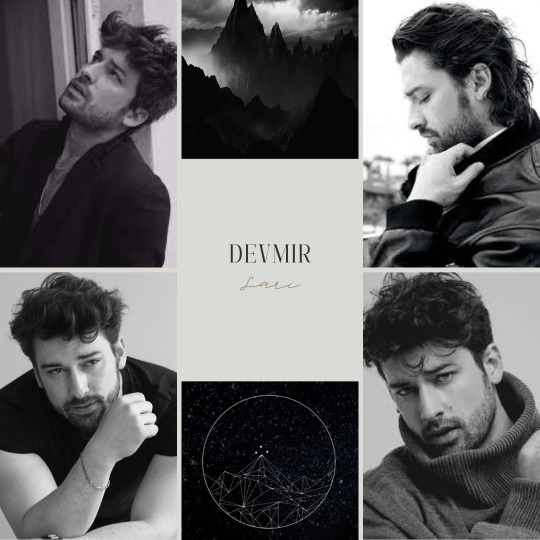
. ✧ . * . ˚ ━━ 「 ALP NAVRUZ, CIS MAN, HE/HIM. 」 welcome DEVMIR SARI, the GENERAL of THE NIGHT COURT, to velaris! it is well known that the 32 / 620 year old ILLYRIAN is HONEST and LOYAL. it is a lesser known fact that they are also IMPULSIVE and RUTHLESS. however, it is a gold siphon that flares to life in the blink of an eye, an undying loyalty to those who have shown their hearts, a silent plea for mercy that goes unanswered, and a promise to someone who is no more that is worn around the neck of a warrior that truly define who they are. in the shadows, their alliance with PRYTHIAN makes them a force to be reckoned with. truly, who knows what to expect of them. cauldron save them, mother hold them.
ABOUT.
There is nothing that compares to life in the Illyrian war camps. To those who have never set foot in one, the Illyrians seem barbaric and ruthless, but to those who have been there…they know the truth, and it’s far worse than what the outside world knows. Though Devmir is now in a position of power, he sits in the inner circle to the high ruler of the night court, his journey to get there has not been easy. Everyone he has ever loved has been taken from him and the horrors of war have destroyed the once childlike view he had of the world.
Six hundred and twenty year ago in an Illyrian war camp, a mother gave birth to the little winged child who would one day lead armies into battle and bow before the high ruler of this land. Devmir was a quiet and introspective child, but he was fierce with an Illyrian blade from the moment he’d learned to wield one and he was most at home among the clouds with the wind on his wings. Though his father was cruel and his siblings were fearful of the man, Devmir never looked away from the monster who hid behind the mask of a loving man. He knew the secrets that hid beneath the surface but he was never afraid. Everyone in his family knew that once Devmir was old enough, strong enough, he would stand up to their father and things would change. And so they did.
Devmir entered the Blood Rite as soon as he was skilled enough, becoming one of the youngest of his time to ever reach a Carynthian title by reaching the monolith at the end. When he returned home, his father was gone, in fear of what Devmir might do now. A new era for the Sari family began. By the time the war came around, Devmir was an elite warrior, his six gold siphons proving his power to all who fought alongside him. Friends were lost in that war but more were made and when they emerged victorious, Devmir had formed a brotherhood with the current high lord.
He served his high lord until the day their new ruler, Rhaeya Einar, came to power. He swore his allegiance to her and kept his armies in line during the transition, knowing that it could be a time of unrest as the Illyrians adapted to a new ruler. While he was simply the general of the armies, Devmir always knew his place was at his ruler’s side. He would be faithful and true until his dying breath and everyone in the inner circle knew his loyalties ran deeper than anything else. Devmir would lay down his life for any of them if needed.
After Amarantha and on the cusp of another war, is when Devmir met Xamira. She wasn’t his mate and he knew that, they both did, but it didn’t matter. Devmir swore to give her everything she ever wanted or needed. She was one of the few people who had never looked at him as some Illyrian brute but had seen past his rough exterior into his soft heart and loved him for it. He promised Mira that once the war was over, they’d have a life together that they’d dreamed of. All the plans they’d made were going to come to fruition the moment there was peace in their lands and he could guarantee her safety. He gave her a gold ring before he left. He came home at the end of the war to the ring in a little box, blood stained and tarnished, and a reminder of how cruel war could be.
Since Mira died, Devmir has been different. He wears the ring on a chain around his neck always and reminds himself daily that he is still moving forward for her. That someday in the next life he will find her again and he will give her all the things he promised her in this one. Though his heart is kind, Devmir has no qualms about the ruthless and dark nature of his position. He knows what he must do to protect his home and his family and he is willing to cut down a path with his blade through their enemies if need be. Anything to protect Prythian. Anything to protect Velaris.
2 notes
·
View notes
Text
FFXIVWrite Prompt 17: Novel
Prompt 17: Novel
Music: (Honestly Wisp’s “theme” pre-Shadowbringers/light poisoning era): Vienna Teng - Landsailor: https://www.youtube.com/watch?v=Hm4BAEa1vBY
Pat Benatar - We Belong: https://www.youtube.com/watch?v=I1VMuTpnzF4
Characters: Wisp Alsentia; mentioned: members of Aetherflow Investigations; Onawa Rider
Wisp tipped their head back, eyes on the ceiling, where shadows of leaves - real? Imagined? - sprang to life and faded, and they smiled.
Music thrummed through them, and around them the hums and murmurs and cheers of the crowds became part of it, thread linked to thread in a tapestry of sound.
It was certainly a novel experience, packed into a crowded room alongside a just-met once-dragon-now-man while performers took the stage, singing in languages known and uknown. Initially their pulse had raced too fast, breath coming short at the crowds, the noise, the windowless state of the room. They had guessed it would, but to refuse Ushumgallu had seemed rude, especially when Sari had also looked at them with what they may have imagined was expectation. And Ushumgallu’s presence was somehow…insistent, his obvious enjoyment of the music infectious. A surprise, somehow, in contrast to Stari’s obvious anxiety about speaking with him. To see Kurenai perform had been a boon - a wonder - and to run into Madi here, and Gravy, and Khala, and, most unexpectedly, Onawa, had been…a pleasure, they realized. Although the brief exchange with Onawa, who had waved her pipe in greeting, had left them flooded with guilt: how had they not sought her out, after their return…?
But now, one of the performers of the Shroud had retaken the stage, and magick flooded the hall.
They could feel it singing to something in them, and leaned back against the wall, eyes drifting shut. Ushumgallu had taken Sari back to the floor to dance, and Madi had found another dance partner, as well, after what Wisp was sure had been a poor performance on their own part - but, fun? Yes, fun. So different from the wild run-dancing of their childhood, to the heavy drum beats cast on waist-high drums of wood and animal skin, loud enough for their father to feel the vibrations even though he could hear none of it.
Aether rose to the call of the song in them, warming their hands, and they breathed in the taste of the Shroud. Similar, but different to the taste of their own aether - or, whatever aether this was - on their tongue.
Some distant piece of them - beyond even the constant flow of worries about Josie, the case, the moss starting to grow up their bedposts while they slept, their tangled aether - knew that they would pay a price, for this, later.
But for now, they smiled, as faerie glow and butterflies and leaves danced on the waves of the performers’ magick, and they let the music wash over them, and the song run through their veins like honey, golden.
4 notes
·
View notes
Text

In the golden glow of a future where technology meshed seamlessly with tradition, Anika stood amidst the flowering fields of East New Britain Province, now known as the Agritech Heartland of the Pacific. The sun cast its warm embrace over the endless rows of genetically optimized flora, infusing the air with the sweet scent of innovation.
Anika, a descendant of the province's native Tolai people, was adorned in a sari that shimmered with both the lush heritage of her ancestors and the subtle integration of smart fibers that responded to her emotional and physical state. Her jewelry, a harmonious blend of ancient design and nanotechnology, glittered intelligently, syncing with the bio-rhythmic energy fields that safeguarded the crops.
A renowned Ethno-botanist, she was a guardian of both the past and the future. Her life's work was to merge the botanical wisdom encoded in her culture with the boundless possibilities of science fiction made reality. In her field, amidst bio-luminescent flowers and photovoltaic trees, she felt the pulse of the Earth and the data streams from the high-orbit satellites in equal measure.
Today was different. An unexpected anomaly had arisen—a singularity that whispered to her from the soil itself. The local AI, which usually operated the vast agricultural network with silent efficiency, had alerted her to an unusual genetic pattern sprouting in an isolated corner of the field.
As she approached the location, the earth beneath her feet hummed with a strange frequency. There, bursting through the ground, was a plant unlike any other. Its leaves were a tapestry of silver and emerald, and its core emitted a soft, pulsating light. Anika reached out with her cybernetic glove, designed to interface directly with the plant's cellular structure, and felt a surge of communication.
The plant was an emissary, a natural probe sent by an extraterrestrial intelligence. It carried within it the genetic memories of a distant world, eager to share and blend with the Earth's own. Anika realized that this was not mere chance; the plant had chosen this place for its first contact, recognizing the symbiosis between tradition and progress that East New Britain Province exemplified.
With careful excitement, Anika initiated the protocol for such a momentous discovery. The plant's message was clear: an invitation to a galactic garden, where species from different worlds exchanged their botanical treasures in a celebration of life's diversity.
East New Britain Province, once a remote jewel in the Pacific, was to become the cradle of interstellar agriculture, blending the richness of Earth's past with the boundless potential of the cosmos. Anika, a daughter of the Earth and a child of the stars, would lead the way into this brave new era of cosmic cultivation.
0 notes
Text
Outfits throughout the eras & countries
As far back as history goes, fashion has always existed there. Every age is shown through a unique painting method, and the same is true of fashion. Fashion varies not only between eras but also between regions. We will come across a wide range of cultural diversity, materials, and other things as we go from north to south and east to west. However, the thing about fashion is that it travels the entire world and is not limited to a certain place. In the beginning, clothes and fashion were restricted to a certain place or territory. However, the time has now changed. People are eager to acknowledge the diverse variety of cross-cultural relationships everywhere in the world and are ready with open hands to explore the world of fashion across the globe.
Let's dissect the fashion trends from different parts of the world and have a close look at how they change from place to place.
INDIA
The Indian subcontinent's women wear sarees, which are made of an unstitched length of cloth that has been woven over the body like a robe. One end of the fabric attaches to the waist, while the other end rests over one shoulder like a stole or shawl, occasionally exposing some of the tummy. Its length and width can vary from 4.1 to 8.2 meters (4.5 to 9 yards) and 60 to 120 centimetres (24 to 47 inches), respectively. The Nivi style is the most often used term and style for sari manufacturing and draping. The choli, or fitted bodice, and the ghagra, parkar, or ul-pavadai, or petticoat, are worn with the sari. In the Indian subcontinent, it is still in style today.
SOUTH KOREA
The hanbok is a traditional article of clothing worn by Koreans. South Koreans are the ones who call the clothing hanbok, but North Koreans call it chosn-ot (조선옷, lit. "Korean clothes"). The Korean diaspora, particularly Koreans living in China, also wears the clothing. The components of the traditional hanbok were the jeogori (top), chima (skirt), baji (pants), and po (coat). The basic form of the hanbok included numerous Mu-ism themes and was made to be easily movable. The majority of people's hanbok was entirely white and adorned with no design for thousands of years. Usually, extravagant hanbok was saved for important events like weddings. Commoners, or seomin, were for a while even prohibited from regularly wearing bright hanbok.
JAPAN
Japan's national attire is the kimono, a traditional piece of clothing. Unless the wearer is deceased, the kimono is a wrapped-front garment with square sleeves and a rectangle torso that is worn with the left side wrapped over the right. The kimono is typically accessorized with tabi stockings and zōri sandals. It is typically worn with a thick belt called an obi. Kimonos are made according to a predetermined technique and are usually created from a long, narrow bolt of cloth called a tanmono, however, fabric bolts in the Western style are also occasionally utilized. Men, women, and children can choose from a variety of kimonos depending on the event, the time of year, the wearer's age, and less frequently these days by their marital status.
SOUTH AFRICA
In South Africa, the traditional dress is called Dakshi, which is a colourful garment worn on the upper half of the body. A dakshi has both formal and informal versions and it varies from fully tailored suits to simple draped pieces. It is commonly seen as or tailored with an ornament v-shaped neck with the neck and sleeve line being embroidered and usually tailored as a loose-fit pullover garment. It is often worn with a brimless cap which is worn by the Muslim community from Africa and the African diaspora. The word "dashiki" comes from a Yoruba loanword ‘dàńṣíkí’ , which means 'shirt' or 'inner garment'.
INDONESIA
It is officially recognized that the kebaya is Indonesia's national garment. It is typically constructed of light materials like cotton, voile, gauze, lace, or brocade. Occasionally, it is adorned with embroidery and worn over the upper body. Pins, buttons, or brooches are used to keep it intact. Currently examining the lower garment, is referred to as a sarong, kemben, or kain. It is a lengthy piece of clothing that is worn and tucked either beneath the armpit or around the waist.Generally, ikat, tenun, songket, or batik are used to make sarongs. Many Southeast Asian airlines, such as Singapore Airlines, Malaysia Airlines, Royal Brunei Airlines, and Garuda Indonesia, have opted for Kebaya as the uniforms for their female flight attendants, making the traditional dress a fashion icon in the region.
As we've already discussed, just as fashion varies from place to place, it also does so across historical periods. Let us now explore the evolution of fashion across time.Even though fashion has been changing throughout the different eras, three eras have made a significantly noticeable evolution throughout the times. These are the Renaissance era, the Victorian era and the Art Deco era. Now let's dive into each era and get to know the clothing difference from each era.
THE RENAISSANCE ERA
The Renaissance era (14th-17th century) was a period of cultural rebirth in European history characterized by a resurgence of interest in classical art, literature, and learning. It saw a turn toward individuality, science, and humanism, which shaped artistic, social, and cultural advancements that still have an impact on contemporary society.
The development of the merchant class led to changes in fashion, while nobles displayed their wealth with elaborate decorations and luxurious materials. Men wore ornate hose, breeches, and doublets, often decorated with jewels and fur trimmings; ladies wore full dresses with structural corsets, rich draperies, and fitted bodices. Ethical principles were reflected in fashion, which emphasized natural shapes. Men's codpieces and women's farthingales, which stood for both social standing and creative expression, were iconic components. For both men and women, Renaissance dress left a long-lasting legacy of grace and creativity.
THE VICTORIAN ERA
Named for Queen Victoria, the Victorian era (1837–1901) was a time in British history marked by social reforms, industrialization, and rigid cultural standards. It was a time of great technological progress, a growing British Empire, and well-defined social divisions. Victorian literature, architecture, and fashion all reflected the ideas and values of the time, with a focus on gender roles, morality, and manners.
Women's clothing during the Victorian era was characterized by ornate gowns with voluminous skirts kept up by bustles or crinolines. These dresses were decorated with lace, ribbons, and elaborate needlework, and they frequently had tight waistlines and high necklines. Tailored suits consisting of fitted jackets, waistcoats, and pants usually came in subtle hues and patterns as men's fashion matured. Men are accessorized with cravats, pocket watches, and top hats, while women wear jewellery, parasols, and gloves. Accessorizing was important for both genders. Victorian fashion showcased the era's technological innovations and cultural inspirations while also reflecting the values of society, which included humility, respectability, and uniformity.
THE ART DECO ERA
The Art Deco period (the 1920s–1930s) was a time of creative art and design defined by geometric shapes, vivid colours, and rich materials. Art Deco embraced modernity and sophistication, incorporating elements from various cultural influences, such as ancient Egyptian and African patterns, and had an enormous effect on architecture, fashion, and the visual arts.
The Art Deco period saw a dramatic change in fashion that reflected the vibrant spirit of the day. The freeing "flapper" look, which was defined by knee-length skirts, dropping waistlines, and lavish embroidery or beading, was adopted by women's clothing. Because of their fluidity, materials like silk and chiffon were preferred, while long strands of pearls and cloche hats were popular accessories. Men's fashion, on the other hand, embraced a more streamlined form, with cut suits that had structured shoulders, straight-leg pants, and small lapels. Luxurious materials radiating elegance and class, such as wool and tweed, were widely used. Gentlemen's professional looks were finished with fedora hats, tie pins, and cufflinks.
In conclusion every era and culture adds a different thread to the thread of fashion history, from the ornate clothing of history to the modern fusion of global trends. Clothes have represented cultural values, social conventions, and personal identity for thousands of years, serving as more than just an article of clothing. Fashion captures the ideals, ideologies, and aesthetics of the era it is designed for, whether it is seen in the luxurious silks of imperial China, the elaborate draperies of Greco-Roman robes, or the cutting-edge designs of haute couture. Furthermore, fashion is a global phenomenon that mixes elements from other cultures and historical periods. Global fashion is enhanced by the variety of sartorial traditions, from the regal presence of the kaftan in the Middle East to the grace of the kimono in Japan. Despite these differences, innovation, self-expression, and the unwavering desire for beauty are the commonalities that connect fashion overtime periods and geographical areas. Humanity tells its stories, welcomes its diversity, and celebrates its creativity through fashion, making a lasting impression on history. We wholeheartedly welcome you to our fashion world VERVE to explore the new colours of fashion to find your own unique persona.
0 notes
Text
From Loom To Life: The Timeless Elegance Of Handcrafted Textiles
Introduction
In today's fast-paced world, where technology seems to dominate every aspect of our lives, there's something profoundly captivating about handcrafted textiles. These pieces, woven with care and precision, carry with them a sense of tradition, history, and timeless elegance. In this article, we delve into the world of handcrafted textiles, exploring their significance, beauty, and the craftsmanship behind them. Along the way, we'll also discover the role played by companies like Bharat Hosiery Factory in preserving this rich heritage while innovating for the modern era.
The Essence of Handcrafted Textiles
Handcrafted textiles have been an integral part of human civilization for centuries. From the intricate tapestries of medieval Europe to the vibrant saris of India, these textiles reflect the cultural identity and artistic expression of communities around the world. What sets handcrafted textiles apart is not just their visual appeal but also the labor-intensive process involved in their creation.
At the heart of handcrafted textiles lies the loom, a simple yet powerful tool that has been used for millennia to weave fibers into intricate patterns. Unlike mass-produced fabrics churned out by machines, handcrafted textiles are imbued with the personal touch of the artisan. Each thread is carefully selected, each knot meticulously tied, resulting in a piece that is not just a product but a work of art.
The Role of Bharat Hosiery Factory
In the realm of handcrafted textiles, Bharat Hosiery Factory stands out as a beacon of quality and craftsmanship. For decades, this esteemed company has been synonymous with premium ropes and cords, catering to a diverse range of industries and applications. From furniture cords to packaging solutions, Bharat Hosiery Factory has been at the forefront of innovation, constantly pushing the boundaries of what is possible with textiles.
One of the flagship products of Bharat Hosiery Factory is its braided polypropylene rope, known in the market as BharatDori. Crafted with precision and attention to detail, BharatDori epitomizes the blend of tradition and modernity that defines handcrafted textiles. Made from high-quality polypropylene line, this rope boasts superior strength, durability, and versatility, making it the preferred choice for various applications.
But Bharat Hosiery Factory's commitment to excellence doesn't stop there. The company also offers a range of other premium ropes, including polyurethane rope, each meticulously crafted to meet the highest standards of quality and performance. Whether it's for industrial use or outdoor adventures, Bharat Hosiery Factory has a rope to suit every need.
Preserving Tradition, Embracing Innovation
In today's rapidly changing world, the demand for handcrafted textiles is as strong as ever. Consumers are increasingly drawn to products that tell a story, that carry with them a sense of history and authenticity. And companies like Bharat Hosiery Factory are leading the charge, preserving age-old traditions while embracing new technologies and materials.
While the loom remains at the heart of handcrafted textiles, modern innovations have also played a crucial role in shaping the industry. Advanced weaving techniques, eco-friendly dyes, and sustainable practices are just some of the ways in which artisans are adapting to the demands of the 21st century.
The Artisan's Touch
At the heart of every handcrafted textile is the artisan, whose skillful hands bring raw materials to life. These craftsmen and women possess a deep understanding of their craft, honed over years of practice and dedication. From spinning yarn to operating the loom, each step in the process requires precision and expertise.
The artisan's touch is what sets handcrafted textiles apart from their mass-produced counterparts. It's in the imperfections, the irregularities, that we find beauty and character. Unlike machines, which churn out perfect replicas, artisans infuse their work with personality and soul. Each piece tells a story, a reflection of the individual behind it.
Bharat Hosiery Factory recognizes the importance of this human element in the creation of handcrafted textiles. That's why the company places a strong emphasis on craftsmanship, investing in training and development programs to nurture the next generation of artisans. By preserving traditional techniques and passing on invaluable skills, Bharat Hosiery Factory ensures that the art of handcrafted textiles continues to thrive.
Sustainability and Ethical Practices
In an age of environmental consciousness and social responsibility, the textile industry faces growing scrutiny over its impact on the planet and its people. Mass production has led to widespread pollution, deforestation, and exploitation of workers, prompting consumers to seek out alternatives that are eco-friendly and ethically produced.
Handcrafted textiles offer a sustainable solution to these pressing issues. By embracing natural fibers and traditional dyeing methods, artisans minimize their environmental footprint while supporting local communities. Furthermore, the emphasis on craftsmanship means that products are made to last, reducing the need for constant replacement and waste.
Bharat Hosiery Factory is committed to sustainability and ethical practices in its operations. The company sources materials responsibly, opting for eco-friendly options wherever possible. Additionally, it ensures fair wages and safe working conditions for its employees, fostering a culture of respect and dignity.
By prioritizing sustainability and ethical practices, Bharat Hosiery Factory not only aligns with the values of conscientious consumers but also contributes to the long-term viability of the textile industry as a whole.
The Future of Handcrafted Textiles
As we look ahead to the future, the allure of handcrafted textiles shows no signs of waning. In an increasingly homogenized world, consumers crave authenticity, individuality, and connection. Handcrafted textiles offer all of this and more, providing a tangible link to our past while pointing the way forward.
With companies like Bharat Hosiery Factory leading the charge, the future of handcrafted textiles looks bright. By embracing innovation, preserving tradition, and prioritizing sustainability, these companies are not just surviving but thriving in a rapidly changing marketplace.
As consumers become more conscious of the impact of their purchasing decisions, the demand for handcrafted textiles is only set to grow. And as long as there are artisans with a passion for their craft and companies committed to supporting them, the timeless elegance of handcrafted textiles will continue to enrich our lives for generations to come.
Conclusion
In the intricate weave of human history, handcrafted textiles stand as enduring symbols of creativity, tradition, and craftsmanship. From the looms of ancient civilizations to the bustling workshops of today, artisans have woven together threads of culture and heritage to create masterpieces that transcend time.
In our exploration of handcrafted textiles, we've seen how companies like Bharat Hosiery Factory play a pivotal role in preserving this rich legacy. Through their dedication to quality, innovation, and ethical practices, they ensure that the art of handcrafting textiles continues to thrive in a rapidly changing world.
As we bid farewell to this journey through the world of handcrafted textiles, let us carry with us a newfound appreciation for the labor of love that goes into each and every piece. Let us support artisans and craftsmen, whose skill and passion breathe life into fabric and fiber. And let us embrace the timeless elegance of handcrafted textiles, knowing that in their beauty lies a connection to our past and a promise for our future.
#bharat hosiery factory#premium ropes#braided polypropylene rope#polypropylene line#polyurethane rope#bharatdori#braided polypropylene#cord yarn#cord rope#pack rope#cord and rope#polypropylene cord#buy polypropylene rope
0 notes
Text
Bharatanatyam readymade costume

In the world of Indian classical move, Bharatanatyam holds a uncommon put. This centuries-old craftsmanship frame consistently combines elegant developments, complicated narrating, and shocking visual aesthetics. One of the basic components that contribute to the mesmerizing excellence of Bharatanatyam is the Bharatanatyam outfit. In this comprehensive direct, we dig profound into the world of Bharatanatyam clothing, investigating its history, noteworthiness, components, and the creativity included in its creation. Disclosing the Wealthy History To really appreciate the charm of Bharatanatyam outfits, one must get it the wealthy history behind them. Bharatanatyam, starting within the southern locales of India, encompasses a bequest that dates back over two thousand a long time. Initially known as 'Sadhir Attam,' this move frame was performed in sanctuaries as a shape of revere, and the clothing was straightforward, reflecting the devout and otherworldly quintessence of the dance. Over time, Bharatanatyam advanced and adjusted, consolidating components from different lines and societies. The ensemble, as well, experienced changes, in the long run getting to be the dynamic and intricate gathering we see today. The Centrality of Bharatanatyam Costume The Bharatanatyam outfit plays a essential part within the move, because it upgrades the dancer's developments, communicates the character's feelings, and interfaces the entertainer with the group of onlookers on a significant level.
Bharatanatyam readymade costume
Practicing indian classical dances
Bindi kumkum and kajal
Fashion costume jewelry
Bharatanatyam costumes female
Dance costume stitching
Ankle bells and ghungroo
Let's break down the noteworthiness of each component:
1. Sari: The Tastefulness of Drapery The sari is the foundation of the Bharatanatyam ensemble. It is regularly made of silk, known for its shiny luster and wealthy surface. The way the sari is hung and creased isn't fair for aesthetics but moreover for useful reasons. The creases permit for liquid leg developments, whereas the pallu (the free conclusion of the sari) includes elegance to arm motions. Dynamic colors and complex plans make the sari a visual feast.
2. Adornments: Embellishing the Dancer No Bharatanatyam ensemble is total without gems. The artist wears a assortment of adornments, counting sanctuary gems, decorated with perplexing themes of divinities. These embellishments not as it were emphasize the dancer's excellence but too carry social and typical significance.
3. Cosmetics: Communicating Emotions Cosmetics is an indispensably portion of the Bharatanatyam outfit. It involves complicated specifying of the eyes, lips, and confront. The expressive makeup enhances the dancer's capacity to communicate a wide extend of feelings, making the execution more captivating.
4. Embellishments: Anklets and Bells The sound of anklets and chimes is synonymous with Bharatanatyam. These decorations are worn on the dancer's feet and deliver pleasant sounds with each development. They serve both cadenced and stylish purposes, including profundity to the performance. The Craftsmanship Behind Bharatanatyam Costumes Making a Bharatanatyam outfit is no conventional task; it requires the gifted hands of artisans who have aced this make over eras.
0 notes
Text
HISTORY, ORIGIN AND DEVELOPMENTS IN SAREE FASHION
You have seen the modern versions and draping styles of the saree. But do you know the origin of sarees? How has it evolved through the ages? Find out here.
The saree or sari is a quintessential part of Indian culture and tradition. Sarees are a must-have elegant attire for women and are worn at weddings, parties, and festivals..
The word ‘saree’ or ‘sari’ is a Sanskrit word that means ‘a strip of cloth’. It is derived from the Prakrit word, sattika, which is mentioned in ancient Jain and Buddhist literature. With time, it took on the term ‘sati’ and eventually became known as ‘saree’.
The journey of “TrendOye – being different” began in the year 2018 with the modest start from our home-sweet-home with offering Unique Indian Ethnic Fashion with regional variations of India, considering different & latest trend. Trendoye which means being different. After the offline penetration, we launched our online store in 2018. Today, it aspires to become world's preferred destination for affordable yet high quality trendy Indian Ethnic Fashion, and intend to set altogether a new standard of fashion and customer satisfaction.
The saree is worn by women of South Asian countries, like India, Pakistan, and Nepal, as an everyday and special occasion attire. But over the years, traditional Indian sarees have gained immense popularity in fashion industries across the world.
This most popular Indian attire is worn by women of all ages and at different stages of life. It has taken on quintessential representations of Indian traditional and feminine wear. But how did it come to be in the styles and forms of today? What is the saree drape origin? Let’s find out.

Origin of Sarees
The origin of sarees can be traced back thousands of years. In popular history, the birth of sarees dates back to ancient civilisations, with the Indus Valley cited as the first place to wear saree in the Indian subcontinent. The first mention of the saree is seen in the Rig Veda and the epics like Mahabharata and Ramayana.
What takes on highly fashionable forms today was originally just a humble, functional garment. According to most depictions, when sarees started , they were worn as unstitched pieces of cloth. It is believed that the drapes flourished during 2800 BC-1800BC across the Indian subcontinent. There is evidence of saree-like garments being worn by women in different parts of the world, but the draping style and silhouettes are different from what we see today.
Evolution of Saree
Various ancient Indian empires, including the Guptas, the Mauryas, the Mughals and even the British Raj, have contributed to the evolution of the saree. The form of the saree we see today was developed in the post-Mughal era. Under the influence of various cultures and traditions, different methods of weaving, dyeing and printing of fabric were developed.
Thus, every great epoch and dynasty has had a significant impact on the evolution of the saree. Let’s take a look at some of the key developmental changes of sarees:
The origin of sarees was with the use of cotton, as the textile was prevalent at the time. But eventually, specifically during the pre-industrial times, silk was developed in China and later introduced in India through the Silk Road. This marked the origin of silk sarees.
After industrialisation, synthetic dyes were used in the making of sarees. Around that time, different techniques of dyeing and printing were also developed.
Stitching was introduced to India by the Greeks. It became so popular that eventually, every region of India developed a unique style of stitching.
The Mughals brought traditional embroidery, embellishments and patterns to India. With the richness of the Mughal fabric and the intricate designs of the skilled Indian weavers, a dazzling variety of sarees was developed. The most famous among them was the Banarasi saree.
The saree was worn without blouses and petticoats before the British Raj. But during the Victorian era, blouseless sarees were seen as improper. So, the British promoted wearing blouses and petticoats with the saree.
Later, various types of regional handloom saris made of silk, ikkat, cotton, embroidery, block-print, and tie-dye textiles were developed. There has been a dramatic transformation in the use of fabric, motifs and embellishments for making sarees over a period.
Today, in various parts of the country, sarees are worn not just for fashion but for daily use, too. Sarees are popularly touted as one of the most versatile and comfortable garments ever.
With the development of the textile industry in India and increasing foreign influence, the saree became the first Indian garment to be recognised internationally.
Source - https://trendoye.com/blogs/news/history-origin-and-developments-in-saree-fashion
2 notes
·
View notes
Text
Walk in Hairdressers Toowoomba
With over 21 years of experience Sarie has a holistic view to hairdressing, connecting with her clients before scissors or colour are even touched. Ginger Cartel was previously a city-scape styled salon and now resides at Central Plaza on Ruthven & Long Street, Toowoomba. With inspirations from the 30’s era and speakeasy theme of her name, Sarie has created a salon space where she hopes to bring luxury and prestige expert service to Toowoomba.
Walk in Hairdressers Toowoomba with a range of services from haircutting, hair treatments and keratin smooth treatments to hair extensions and personalised consultations they’re an excellent choice for your next Toowoomba hair appointment. They also offer valuable packages and gift vouchers to add a little extra oomph to your experience with them.
Lavya Hair Design are your first choice for a Hairdresser in Toowoomba for modern hair cuts, crisp clean hair colours and naturally nourished hair.
Visit our brand new salon in Toowoomba Plaza near Kmart, where you can relax in style and be pampered whilst enjoying our affordable hair package deals.
#walk in hairdressers toowoomba#hair stylist toowoomba#hairdressers in toowoomba qld#hairdresser toowoomba city
0 notes
Text
Flaunt Your Legs: The Allure of Split Leg Skirts in Modern Fashion
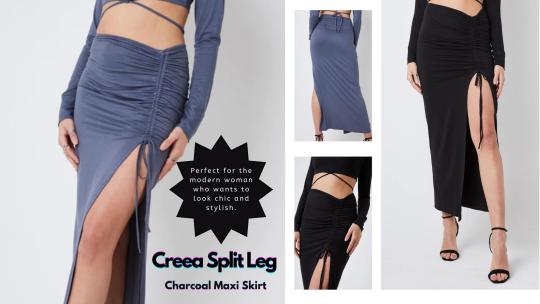
In the ever-evolving world of fashion, trends come and go, but some styles possess a timeless appeal that remains irresistible. Enter the enchanting world of split-leg skirts. These daring creations have made a remarkable resurgence in contemporary fashion, captivating the hearts of fashion enthusiasts and style mavens alike. The allure of split-leg skirts lies in their ability to showcase legs and their unique ability to exude confidence and individuality.
A Brief History of Split-Leg Skirt
Split-leg skirts, also known as slit skirts, have a rich history that dates back centuries. Across various cultures, from ancient Egyptian attire to traditional Indian saris, garments featuring splits or slits have been used to enhance movement while adding a touch of allure. In modern times, split-leg skirts gained prominence during the iconic era of the 1960s and 1970s, when rebellious fashion icons embraced them.
Modern Revival: Split Leg Skirts in the Fashion Scene
In recent years, split-leg skirts have enjoyed a remarkable revival on the fashion stage. These skirts have graced the runways of renowned designers and have become a favourite choice for red-carpet appearances. Celebrities and influencers have embraced the trend, showcasing their penchant for style and glamour. The modern take on split-leg skirts infuses them with a captivating and empowering boldness.
The versatility of Split-Leg Skirts
One of the most enticing aspects of split-leg skirts is their versatility. These skirts come in various styles, from subtle thigh-high slits to dramatic leg-baring openings. This adaptability makes them suitable for a wide range of occasions. A split-leg skirt can effortlessly transition from casual daytime outings to sophisticated evening affairs, ensuring you remain a fashion standout wherever you go.
Pairing Split Leg Skirts with Stylish Tops
When styling split-leg skirts, the top choice is pivotal in achieving a balanced and cohesive look. Consider pairing a split-leg skirt with a cross over crop top for a playful yet elegant ensemble. This combination perfectly balances the skirt's boldness and the top's sophistication. Alternatively, opt for a white ruffled blouse to exude timeless charm while allowing the skirt's unique design to shine.
Creating Chic Outfits: Split Leg Skirt and Mini Skirt Combinations
Fashion is all about pushing boundaries and experimenting with new ideas. The pairing of split-leg skirts with mini skirts exemplifies this innovative spirit. The result is a captivating fusion of daring and playfulness. Imagine donning a pink playsuit that combines the allure of a split-leg skirt with the cheekiness of a mini skirt. Matching sets featuring coordinating tops and skirts offer a cohesive look that effortlessly elevates your style.
Embracing Confidence: Feeling Sexy in Mini Skirts
Wearing a mini-skirt is a declaration of confidence and self-assurance. Mini skirts, like split-leg skirts, celebrate the beauty of the legs and encourage self-expression. The flirtatious length of a mini skirt enhances your natural curves, allowing you to embrace your body with pride. To feel your best, remember that confidence is key. Own your style, rock that mini skirt, and let your attitude shine.
Swimwear Extension: Split Leg Skirt Influence on Beach Attire
The allure of split-leg aesthetics extends beyond traditional attire and into swimwear. Imagine strolling along the shoreline in a one-shoulder cut-out swimsuit that draws inspiration from the split-leg skirt trend. Opt for a white bikini set featuring captivating split-leg bottoms and a flattering triangle bikini top to channel elegance by the water. This combination effortlessly merges beach vibes with chic fashion sensibilities.
Cree Clothing: Incorporating Culture and Identity
Fashion is a powerful medium for expressing culture and identity. The influence of split-leg skirts can be seen in Cree clothing, where traditional elements seamlessly blend with contemporary styles. This connection is a testament to the significance of preserving cultural heritage through clothing. The split-leg skirt trend captivates the fashion world and showcases the beautiful interplay between tradition and innovation.
Styling Tips: Nailing the Split Leg Skirt Look
To fully embrace the splendour of split-leg skirts, consider these styling tips. Explore patterns, textures, and colours that resonate with your style when choosing a skirt. Experiment with accessories, such as belts and statement jewellery, to add a touch of individuality. Remember that shoes and bags can significantly impact the overall look, so choose to create a harmonious ensemble wisely.
Accessorising for Impact: Elevate Your Split Leg Skirt Outfit
Accessories have the remarkable ability to transform an outfit from ordinary to extraordinary. Enhance your split-leg skirt ensemble by incorporating accessories that reflect your personality. A stylish belt can cinch the waist and add definition, while statement jewellery can draw attention to your neckline. Remember the power of a well-chosen hat or bag to complete the look and make a lasting impression.
Confidence and Individuality: Making the Trend Your Own
Fashion is a canvas for expressing who you are. Embrace the power of clothing to convey your unique identity and style. As you don a split-leg skirt, remember that it's not just a garment—it's a statement. Embrace your confidence and individuality, and let your personality shine through. Customise your split-leg skirt look to align with your preferences and revel in the art of self-expression.
The Subtle Power of Simplicity: White Ruffled Blouse and Split Leg Skirt Combo
Among the myriad styling options, a timeless combination effortlessly blends simplicity and sophistication—pairing a white ruffled blouse with a split-leg skirt. The blouse's ethereal charm complements the skirt's daring design, creating a harmonious fusion of elegance and allure. This ensemble is a testament to the power of subtlety in making a lasting impression.
Creating a Lasting Impression: Styling Tips for Formal Events
Elevate your split-leg skirt game by incorporating it into your formal attire. This bold choice can instantly transform your look into refinement and elegance. Consider pairing a split-leg skirt with a tailored blazer or a sophisticated blouse. Accessorise with pieces that exude luxury and let your outfit speak volumes about your impeccable fashion sense, even in the most upscale settings.
Conclusion
In the ever-evolving fashion landscape, split-leg skirts symbolise boldness, confidence, and self-expression. Their allure lies in their design and the way they empower individuals to embrace their individuality. From casual pairings to formal ensembles, split-leg skirts offer a versatile canvas for showcasing personal style. So, whether you're strolling along the beach or gracing a red carpet event, remember that fashion is not just about trends—it's about embracing your inner confidence and owning the spotlight.
0 notes
Text
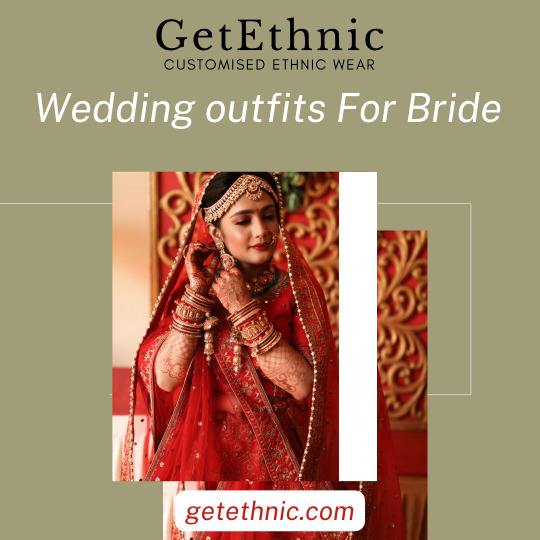
Unforgettable Moments in Indian Bride Dresses: Capturing the Essence of Love and Beauty
The wedding ceremonies in India are famous for their lavishness, splendor, and age-old customs. When all eyes are on the bride, she deserves to feel as beautiful as she looks on her wedding day. Traditional Bridal outfits has changed little throughout the years, but each region has contributed its own twist. These garments are both classic and trendy due to their use of color and embroidery.
Exactly what does an Indian bride wear?
Indian brides traditionally wear elaborate and colorful outfits during their weddings. There are many different parts to it, and they all have their own special meaning and flair. The saree, a long drape that the bride wraps around herself in a variety of ways according to regional customs, is the most significant component.
The saree is typically worn with a blouse, called a choli, which may or may not have sleeves, depending on the occasion. Similarly sophisticated to the saree is the blouse, which is adorned with elaborate embroidery and ornaments.
Jewelry is an integral aspect of any Indian bride's ensemble. Jewelry, including necklaces, earrings, bracelets, and bangles, is an essential part of the bride's ensemble. It's a symbol of success and fortune while also upping the glam factor.
Veils or dupattas (length scarves) and shoes (often embroidered sandals) are two further examples of such items. The ensemble wouldn't be complete without these accessories, making them ideal for a contemporary princess who values heritage without sacrificing style.
Indian Wedding Attire: A Brief History
The tradition of Indian bridal attire has a long and interesting history. Wedding clothing in India has changed over time to represent the country's many different cultural traditions.
The wedding ceremonies of ancient India were low-key celebrations. Weddings, on the other hand, grew increasingly elaborate as society as a whole became wealthier, as a means of displaying said money and position.
Wedding gowns with a lot of silk brocade and gold embroidery were popular during the Mughal era in the 16th century. Most of the time, these clothes were from Turkey or Persia.
In the 17th century, as India opened up to European trade, European styles began to seep into traditional Indian wedding garb. Muslin fabric, imported by the British, was utilized to create airy saris, which quickly became the garment of choice for brides.
Indian Wedding Outfits now combines elements of the past with the present. Many brides still go for elaborate lehengas or sarees, but some are choosing simpler styles that better express themselves.

Dresses Worn by Indian Brides More Often Than Not
Exquisite stitching, elaborate motifs, and brilliant hues are hallmarks of traditional Indian wedding attire. Sarees, lehengas, salwar kameez, and Anarkali suits are typical choices for brides in India.
Sarees are a classic that will always be in vogue. Silk, chiffon, and georgette are just some of the textiles that are commonly used, and they can be draped in a variety of styles that are specific to different parts of India. To shine on their wedding day, many brides pick sarees with elaborate gold or silver work.
Bridal lehengas are also very popular. The combination of a blouse and a dupatta with one of these long skirts is fit for a princess, making it an ideal bridal outfit. Whether the bride prefers a more classic or modern look, there is a Lehenga out there for her.
For a more laid-back look than traditional sarees or lehengas, a salwar kameez is a great choice. Salwar, baggy pants, and kameez, a tunic-like top that can be embroidered or printed, make up this traditional costume.
Anarkali suits' rising appeal might be attributed to their princess-like form; they flare out gracefully from the waist. The necklines and hemlines of these suits are sometimes embellished with elaborate embroidery for a glamorous touch.
Indian brides who want to combine classic style with cutting-edge bridal fashion have a plethora of alternatives available to them. There is a wide variety of bridal wear available, from sarees to Anarkali outfits.
Conclusion
Summarizing, Indian bridal attire is a stunning representation of India's illustrious cultural history. While still steeped in heritage, these exquisite clothes have also been updated to reflect current bridal fashion. Every bride can find an ensemble that speaks to her individuality and sense of taste, from colorful lehengas to elegant sarees.
Indian bridesmaids outfits is also on the rise because of the positive attention it has drawn to the wedding industry. They are great for any wedding event and accurately portray the richness of Indian culture with their traditional yet contemporary patterns.
The evolution of Indian bridal wear from basic fabrics draped over the body to elaborate ensembles embellished with embroidery, jewels, sequins, and stones is documented throughout history.
0 notes